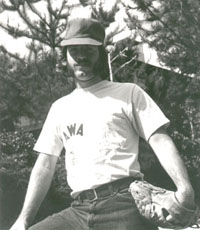 | |

|
There was nothing unusual about a bunch of guys getting together on a sunny summer afternoon to play a little hardball. This typically American recreation could be found on just about any ballfield in the land at this time of year. However, on a blistering, smoggy June day in 1970 at Buchser High
School in Santa Clara, California, two unrelated events generated the spark for what we now know as "AWA". The first was a baseball score book that someone brought that day, an amusing addition to our weekly diversion. The second
event was a collision at first base during the game that resulted in a broken wrist for Mike Applegate, sidelining him for six weeks -- six long weeks of sitting in the stands with that score book in the height of
summer watching his buddies play ball.
The Stat Man was born! And this group of friends would never be the same. While benched with "The Book" and a cast, Mike created the idea of a league from this weekly get-together, complete with six "teams", captains actually, expanding in later years to eight. Two teams would be scheduled to play on a particular day, and those two captains chose their teams from whoever showed up to play that day. Home team, of course, always picked first. Guys brought friends and relatives, who in turn brought other friends. There was always a game afoot in the AWA league. You just had show up and want to play. And what a league it was! Complete with standings and an array of statistics, which gave us our batting champs, E.R.A. leaders, and Most Valuable Players. The pennant race was fought out by teams with names like Christie Air Force Base, the Samurais, Snodgrass Corps, the Barking Spiders, Applewood's Army, the Big White Machine, the Whatchamacallits, the Tasmanian Devils, Joe's Market, Rubin's Winery, Stevie's Stoners, and the Mammary Marauders. The league played out for five years, but the popularity of those weekend games waned with each passing season. By the end of summer in 1974, only a few players were attending on a regular basis. It was getting difficult to field two teams anymore, and although we hated to admit it, we all knew that the 1974 season would be the last for the AWA Baseball League. Meanwhile, Earl Yagi was playing slow pitch softball in a University of Santa Clara intramural league. Now slow pitch softball at that time was connected with company picnics and rowdy beer leagues for over-the-hill jocks who couldn't play real ball any more. That was not us. But Earl took some of the guys out to see what it was really all about, and once we saw the competitiveness and athleticism in these games, we were sold on the idea of taking our recreation to the softball diamond. The Spring of 1975 would be the first season of our new softball team.
 |










